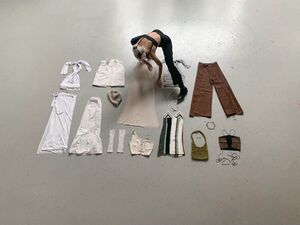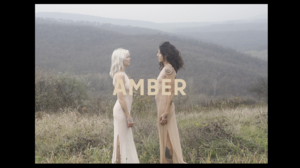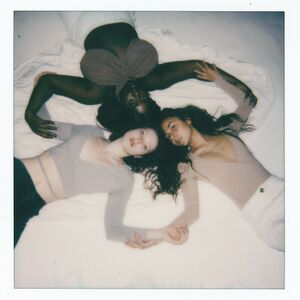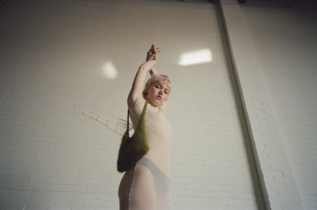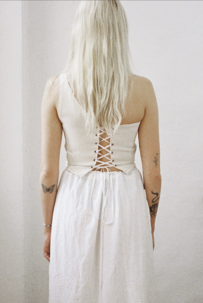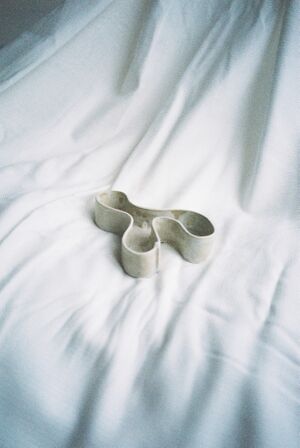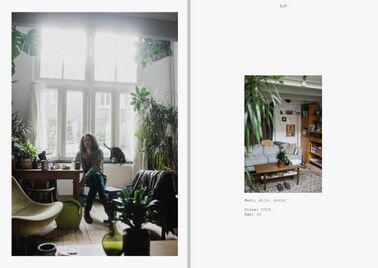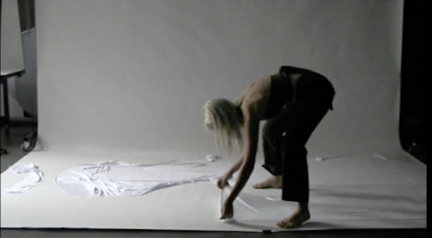Text on practice Clara: Difference between revisions
| Line 66: | Line 66: | ||
The book serves as an analysis of what Berlin is becoming and who we felt we were becoming through moving here. The photography is analog: winter city shots, portraits of those I met and surrounded myself with and photos from protests against the housing crisis that became very present during my time in the city. A city that was known for the freedoms it would offer but that is now victim to gentrification, closing down most communities and creative spaces. | The book serves as an analysis of what Berlin is becoming and who we felt we were becoming through moving here. The photography is analog: winter city shots, portraits of those I met and surrounded myself with and photos from protests against the housing crisis that became very present during my time in the city. A city that was known for the freedoms it would offer but that is now victim to gentrification, closing down most communities and creative spaces. | ||
Having an activist mindset to the housing crisis in several of the places I lived in, I would also like to take this idea further in the future. Possibly through visualising more alternative ways, sustainable ways that humans can coexist in domestic spaces. | Having an activist mindset to the housing crisis in several of the places I lived in, I would also like to take this idea further in the future. Possibly through visualising more alternative ways, sustainable ways that humans can coexist in domestic spaces. The work of Rutger Bregman "Utopias for Realists", for example shows me the direction I think into as an activist; trying to not focus on negative news, but see what can be c hanged and what social and governmental initiatives CAN change. | ||
=== 6. Future Vision === | === 6. Future Vision === | ||
Revision as of 13:25, 22 February 2023
Draft 21.03
1. Introduction
The least limiting, yet relative brief description of my current practice may encompass; multidisciplinary artist and designer currently creating lens based work, costume designs and functional art such as clothing and pottery. Interests focussing on ecofeminism, homes and their artifacts and experimentation with natural materials. I was born in 1998 in suburban Hamburg and lived & studied in Albuquerque (attending Media Arts Collaborative Charter School in 2015), Groningen (Bachelor in Design at Academie Minerva 2022), Berlin (graphic design internship with THE PEOPLE° in 2021), Barcelona and Rotterdam (currently following the Master "Lens Based Media" at Piet Zwart Institute). During my bachelor's degree I decided to study Illustration, Graphic Design and Product Design, while constantly creating photography and graduating with a clothing collection. This shows my interest in a very broad field of design/art practices. While constantly including new mediums in the practice one will always find an overlapping signature, marked by an ethereal softness in an organic, muted color palette, combined with a sense of intimacy and activism.
2. Recent Lens Based Work; Feminist Groundwork
Recently I have been working on the short film “Amber”. The film gives many references to the ethics and aesthetics of my lens based work.
Amber and I met during our teenage years. I decided to portray our (physically)intimate friendship as a symbol for female connection and Amber's knowledge on plants, specifically herbs, as a symbol for nature as a source of healing that, when treated with care and knowledge, can be used for healing purposes.
The work is addressing eating disorders and the connection I have found in this friendship, when sharing both of our experiences, which partially stem from a strong sense of comparison between, especially young, women. This marks my general mental health background and feminist groundwork of most processes. Instead of feeding further into comparisons and jealousy, Amber and I were able to bond at the ages of 16 and 17, over our shared experiences with disordered eating behaviours.
Generally speaking I, as the maker, strive to create an empowering setting for myself and the women I portray in which the layer of comparison moves towards the capturing and celebration of their beauty. Challenged by the deeply ingrained male gaze in photography, especially editorial fashion photography, I see a great need for female photographers, capturing women with the aim to empower instead of sexualise. One of my greatest inspirations in this direction has been Carlota Guerrero. Guerrero creates photographs that connect women to become one organism, visuals induced by her first LSD trip(Psychedelics have also become a place of self development and reflection for myself in the past years). Images that celebrate femininity and the core connection that lies within.
As described on Guerreros website when talking about her work; „Her's is a sidereal trajectory that has much to do with the spirit of the times and with her vision of women as goddesses. A very special goddess: pagan, a friend of her sisters, who does not attend to the industry’s canons of thinness and with a point between the classic, the innocent and the irreverent.“
This feminine energy, turning into Botticelli-esque compositions, I would describe as ethereal, divine. Depicted in images which portray women as angelic, strong yet playful, soft, sensual. Visuals of women in skin toned, flowing fabrics and winged. These are traits I strive to visualise in females, in a setting where they can feel safe and supported.
3. From Fantasy to Ecofeminism
Coming back to the visual of wings, which I have been coming back to since my childhood, from drawing winged humans to creating props and costumes for my own shoots and the Theatre play “Narrow Spaces”, which will premiere in April in Groningen. This visual is first inspired by my childhood readings being mostly fantasy books (for example the Dragonrider series by Cornelia Funke, The NeverEnding Story by Michael Ende or Alice in Wonderland by Lewis Caroll). Still now I enjoy reading stories embracing fantasy and a child-like vision of the Anthropocene such as Le Petit Prince or Walter Moers, which describe my character as one of a dreamer; embracing escapist behaviour into worlds of dreams and absurd creatures, far from the reality I lives in. But at the same time I see creatures like Dragons and fairies as visualisation of the surreal trades of nature itself. A power and beauty we can hardly fathom. This is where the idea of ecofeminism comes into play. What Donna Haraway describes as “the diverse earth-wide tentacular powers and forces collected things with names like Naga, Gaia, Tangaroa, Terra, Haniyasu-hime, Spider Woman, Pachamama, Oya, Gorgo, Raven, A’akuluujjusi, and many, many more.”, describes a personification of nature as a female, goddess like shape. The ecofeminist approach argues that both women and nature have been dominated and degraded by patriarchy and capitalism. Donna Haraway finds a path to betterment in what she calls kinmaking, meaning the vision of a unity and family-esque connection between beings that are not genetically family, or even of a different species. Ecofeminism seeks to promote a more holistic and compassionate relationship between humans and the environment, imagining more sustainable and equitable ways of living to take action towards an environmentally conscious society.
4. Experimentation with Natural Materials; Creating Functional Art
Even though I generally do not support the idea of shaming the individual for the climate crisis, I see an essential role in the movement towards rethinking consumerist behaviors and inspiring to move back towards own creations, meaning slow productions that also benefit one’s mental health.
I myself practiced such in general research and try outs of natural materials like clay, alpaca wool, up-cycled fabrics, eco latex and more. Generally speaking the transformation of natural products. One of the companies inspiring myself most is Paloma Wool. Paloma Wool, started by Paloma Lanna in Barcelona is „acknowledging the fashion industry’s shortcomings enables us to challenge the system we work in.“ They work with local producers around their base in Barcelona and frequently collaborate with artists on small scale produced collections.
My graduation project was the creation of a sustainable clothing collection, made from second hand and self made materials. I choose to also create a magazine on the topic of the fashion industry, reflecting on editorial fashion photography and the meaning behind the pieces we own, the stories a piece of clothing can tell. Next to the magazine and clothing pieces I have created a fashion film and a one shot process video as well as photography prints.This all was presented alongside each other together with raw materials and a spinning wheel on which I performed wool spinning.
The one shot documented the whole 10 minute creation of a two piece. This approach to combine my mediums is something I could imagine taking further in the future, celebrating the mesmerising effect creation can have on our society, that is as disconnected as ever from creation of daily life objects as ever. In my installation, as already mentioned I also spent several hours live spinning wool, to add a performative element and show how, with little experience, one can create own pieces from the start.
The products that I have ben creating are usually asymmetrical and don’t strive to look machine made. In a home space, I believe, we are usually already surrounded by too many perfectly symmetrical, square objects that disconnect from an intuitive human experience.
My graduation year marked a generally stronger focus on crafts such as clothing making (sewing, spinning wool, crocheting, knitting) and pottery (making organically shaped rather practical objects), which I learned in Barcelona.
Pottery has been my meditation and connector to other creators and the natural material, while creating objects that can generate a calmness in peoples homes.
5. Past Work; Home spaces and Their Artifacts
The internal development and conflict when changing homes, the general privilege of having a home and the meaning of every artifact inside one's home have been recurring ideas for me as well.
I, for example, created the short film “Ostblock”, on my Omas travels through, what then was, Eastern Germany and the USSR. This was inspired by a collection of dia photographs I found in my grandmother Gisela's basement as well as the photo albums she created and kept for every trip she has done since her late 20s. The documentary short film alternately shows my grandmother in her home telling about her journey and a selection of the actual dia-photographs. In the stories told give examples to the felt division between east and West Europe during that time, from the experience of one living in West Germany.
I also created two photo books that relate to the idea of homes. One of which has been self published in 2021. The book “The ORKZ” documents 50+people and their rooms/homes in a squatted hospital community, where I lived with a total of 250 other people between 2019-2022. The book gave me the excuse of the camera to step into people's personal spaces and start a conversation based on the artefacts they surround themselves with. I explored how the wide variety of people in this community build themselves a home. This project focussed more on using photography as a tool to start intimate conversations and situations in peoples home spaces, this being one of my comfort zones.
The second photobook(2023, unpublished) documents my time in Berlin in 2021, which combines my friend Maxis poetry with my own photography. The book serves as an analysis of what Berlin is becoming and who we felt we were becoming through moving here. The photography is analog: winter city shots, portraits of those I met and surrounded myself with and photos from protests against the housing crisis that became very present during my time in the city. A city that was known for the freedoms it would offer but that is now victim to gentrification, closing down most communities and creative spaces.
Having an activist mindset to the housing crisis in several of the places I lived in, I would also like to take this idea further in the future. Possibly through visualising more alternative ways, sustainable ways that humans can coexist in domestic spaces. The work of Rutger Bregman "Utopias for Realists", for example shows me the direction I think into as an activist; trying to not focus on negative news, but see what can be c hanged and what social and governmental initiatives CAN change.
6. Future Vision
Thinking forward in my practice, I see a vision of further interdisciplinary practices leading into several directions.
It could possibly be creating more photography work around the themes of ecofeminism and home spaces, or it could lead to the creation of a brand of some sort. What to me used to seem superficial has gained importance when realising the possibilities such an approach could bring. From installations that calm and educate on consumption behaviors and slow creation processes to generally giving an alternative platform for consumption.
Basically taking my Bachelor graduation collection further, creating a more broad variety of objects could be a pathway. These objects could be simply candle holders, photography prints or clothing.
It would be important to me to document processes and be as transparent as possible, and to further research on the ideas behind ecofeminism and exploring new natural materials to work with. Materials like kelp, linen or bamboo.
The work with clay and wool has forced me to slow down and focus on one process for many hours on end.
A company focussed on slow production with natural materials, which translates into peoples homes through the created objects could be an antidote to the constantly speeding up rhythm of life in the Anthropocene.
A rhythm not giving space for connection and reflection on how we interact with each other and Nature as a whole.

